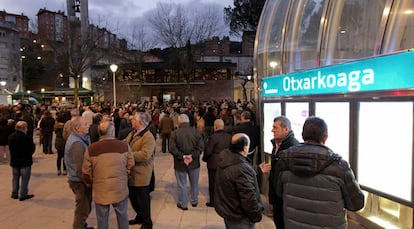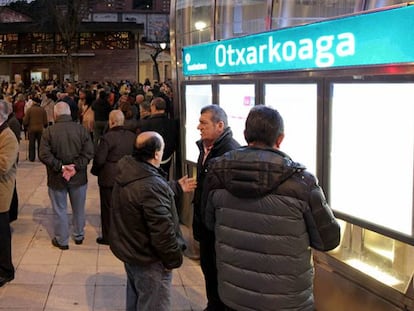Bilbao¡¯s juvenile killers: kids on the outside, ruthless on the inside
Institutions criticized for not doing more to stop the teens who murdered an 87-year-old couple


¡°Two grandparents killed for nothing. Either we do it ourselves or nothing, because the Messiah of Otxarkoaga won¡¯t come.¡± Two rappers are listening to a drum and guitar base on their cellphones in the center of Bilbao. Dressed in black, baggy clothes with their hoods over their head, they rap about the debate that has captured the Basque city ¨C how is it possible that children were able to kill an elderly couple in the city¡¯s working class neighborhood of Otxarkoaga? The bloody murder on January 18 left the city in shock. And the feeling deepened when three minors, two aged 14 and one 16, were arrested for the murder of the 87-year-old couple Luc¨ªa and Rafael.
This had to happen for institutions to take the issue seriously, it¡¯s terrible Bilbao local
One of the 14-year-olds lived in the cement residential blocks located at the upper end of Txotena street in Otxarkoaga. At the local bakery and hamburger shop, neighbors and friends can¡¯t explain how the teenager fell into crime. Robert, a welding and boilermaker student at the neighborhood¡¯s Training Center, says he knew him. ¡°He used to go down these stairs to meet up with his school friends,¡± he says, pointing to a courtyard which can only be accessed via a closed gate with a video surveillance camera. ¡°Sometimes we would go to the shopping center to smoke. He wasn¡¯t a bad guy,¡± says Robert with an ironic smile.
The 14-year-old lived between his mother¡¯s place and the state care of Bizkaia's provincial council. His own mother had told the social services that she couldn¡¯t handle him any more. She did convince the teen to hand himself over to the police after the crime.
His alleged accomplice, another 14-year-old who was detained in Balmaseda and is considered by investigators to be the most violent of the three, had studied at the professional training center as well. One of the arrest warrants issued against him was ordered after he attacked various students to steal their cell phones, as well as the teacher who tried to intervene. Most of his family is behind bars.
In Otxarkoaga, a working-class neighborhood with aging residents where gypsy and non-gypsy communities live side by side peacefully, the two teens were known for other reasons. Petty theft, and more recently, aggravated robbery, had made them infamous in the neighborhood. Their list of crimes steadily escalated. From pushing people around and stealing clothes off other teenagers, they had moved on to robbing old people in the street, sometimes violently.
Headlong rush
A psychiatrist who has treated young people under the state care of the ?lava provincial authorities explains that the mental health of some of the teens is deteriorating more quickly because of the effects of drugs and alcohol. This can lead to gratuitous violence in a context where friendships are based on subordination to other, even more violent youths. ¡°It¡¯s a headlong rush, ¡° says the psychiatrist from his office. ¡°They jump over all the obstacles that are put in their way and they show their status and hierarchy in their society through violence and lack of empathy. It¡¯s tough to say it, but they develop behavior that is cold and ruthless and not typical for people of that age.¡± He explains that this type of behavior is not particular to young people from any particular city. ¡°This could have happened anywhere.¡±
Nobody thought that the robberies were going to lead to this Tendel Association teacher
But it happened in Bilbao. What¡¯s more, a few weeks before the double murder, a group of young people had attacked a couple in a subway station in Bilbao. One of the victims lost an eye in the attack. Two more teens, ages 13 and 16, killed the former soccer player Ibon Urrengoetzea when they knocked him to the ground to mug him. The player hit his head against the pavement and died. Thousands of people on social media have said their children are scared to walk through certain parts of the city, fearing juvenile gangs will rob, threaten or intimidate them. Following the death of Urrengoetxea in late December, police have increased their presence in the city.
¡°Nobody imagined that these young boys could do something like this, that robbery could end up in this,¡± says ?ngel Velasco, from one of the Otxarkoaga neighborhood associations. But in the steep streets of Otxarkoaga, there have been (and continue to be) young people who spend the day smoking marijuana or hashish during school hours, who take pills and drink alcohol despite their young age, who don¡¯t listen to their teachers, who intimidate and mug elderly people in broad daylight, repeating their crimes again and again, yet nothing is done about it.
The spoils from the robberies allow them to maintain a lifestyle which no one in their family has access to. Little by little, the robberies became more sophisticated, from manhandling to mugging, to breaking into the homes of the elderly and most vulnerable ¨C easy victims. ¡°The same day of the double murder I sent an email to the police explaining that the robberies were continuing and describing the culprits,¡± says ?lvaro, a teacher at Tendel Association, which works with young people in Otxarkoaga. ¡°But nobody thought that the robberies were going to lead to this. Gypsies and non-gypsies are united against these crimes,¡± he says.
Judges have reissued a score of pending arrest warrants for minors
Like ?lvaro, many people had also reported the surge in crime: they had spoken to different institutions, and described and identified the perpetrators, but nothing ever happened. Every day, their sense of impunity grew precisely because nothing happened to them. Not their families or teachers who noted their absences, not the social services which received complaints from neighbors, not the local police or the state care centers, not the pressure from the specialized prosecutor office, not the judges who imposed limits, have successfully protected them ¨C from themselves and the rest of the community.
¡°This had to happen for institutions to take the issue seriously, it¡¯s terrible,¡± said one of the women inside the bakery, located next door to the home of the murdered couple.
More arrest warrants
Former soccer player Ibon Urrengoetzea was killed in December by two teens
This week, judges in the Basque region have re-issued a score of arrest warrants to the Ertzaintza regional police force for minors who have committed crimes and are pending judgment. These are warrants from 2016 and 2017 that have not been carried out. Police have been reminded that there are 30 more warrants to locate youths and bring them before the courts or directly into centers. ¡°This situation where minors are left to their own devices is very dangerous,¡± says Velasco, ¡°and it is a terrible breeding ground for juvenile violence.¡±
The institutions must act when a minor is affected by crime, abandonment or negligence. But many minors slip through the cracks. C.R. is 23 years old and was under state care for almost two years for breaking a classmate¡¯s face and arm and getting constantly into fights. ¡°The center treated me very well and they did a great job, but if you want to continue down the wrong path it¡¯s easy. There are tutorials and consultations with specialists, teamwork and other activities but it isn¡¯t a jail. You can walk out and you don¡¯t have a police officer following you.¡±
¡°You have to take into account that guardianship is not the same as detention and that they are minors,¡± says Jes¨´s Guti¨¦rrez, a former children¡¯s ombudsman in the Basque Country, explaining that it is easy for the more dangerous youths to escape institutional control.
Up until they were murdered, the elderly couple Rafael and Luc¨ªa had enjoyed spending time with their family in Otxarkoaga. Meanwhile, teens ran up and down the neighborhood hills, impatiently trying to outdo one another in their race to jump over the hurdles put up by schools, psychologists, teachers, social services, judges and the police. The day of the double murder, the 16-year-old, who lived just one building up from the couple¡¯s home, kept watch while the other two entered through the window into the home of Luc¨ªa and Rafael. For a time, the three successfully kept off the radar screen of the institutions. All three teenagers are now in a juvenile detention center in Zum¨¢rraga, the only such closed center in the entire Basque Country.
English version by Melissa Kitson.
Tu suscripci¨®n se est¨¢ usando en otro dispositivo
?Quieres a?adir otro usuario a tu suscripci¨®n?
Si contin¨²as leyendo en este dispositivo, no se podr¨¢ leer en el otro.
FlechaTu suscripci¨®n se est¨¢ usando en otro dispositivo y solo puedes acceder a EL PA?S desde un dispositivo a la vez.
Si quieres compartir tu cuenta, cambia tu suscripci¨®n a la modalidad Premium, as¨ª podr¨¢s a?adir otro usuario. Cada uno acceder¨¢ con su propia cuenta de email, lo que os permitir¨¢ personalizar vuestra experiencia en EL PA?S.
?Tienes una suscripci¨®n de empresa? Accede aqu¨ª para contratar m¨¢s cuentas.
En el caso de no saber qui¨¦n est¨¢ usando tu cuenta, te recomendamos cambiar tu contrase?a aqu¨ª.
Si decides continuar compartiendo tu cuenta, este mensaje se mostrar¨¢ en tu dispositivo y en el de la otra persona que est¨¢ usando tu cuenta de forma indefinida, afectando a tu experiencia de lectura. Puedes consultar aqu¨ª los t¨¦rminos y condiciones de la suscripci¨®n digital.










































